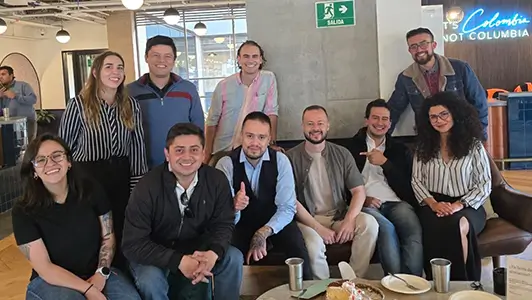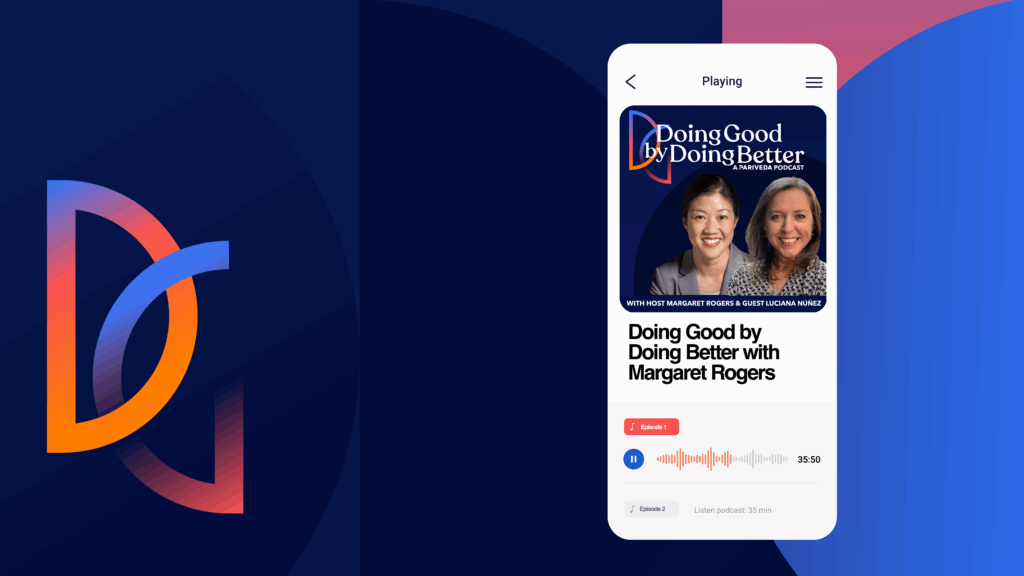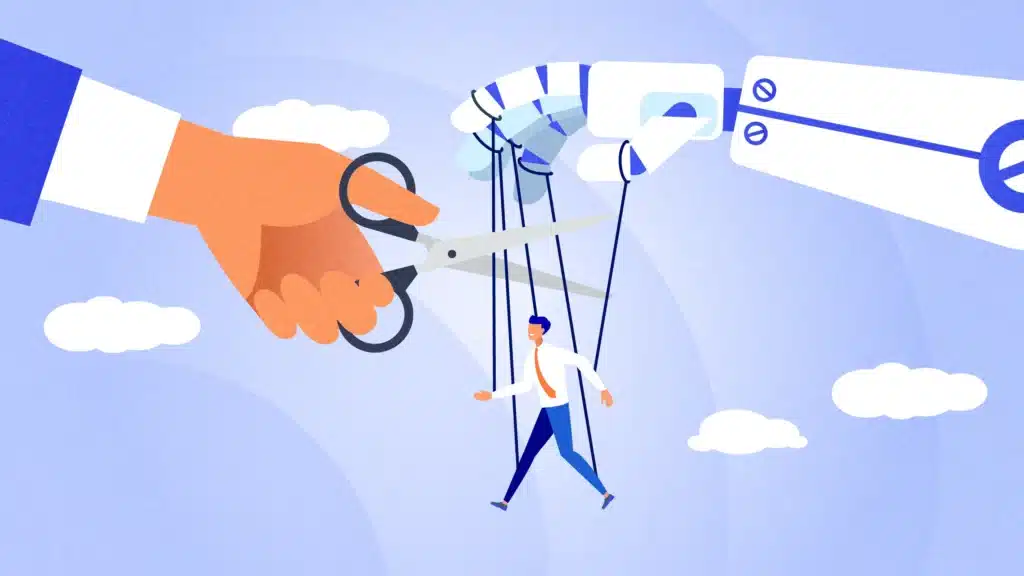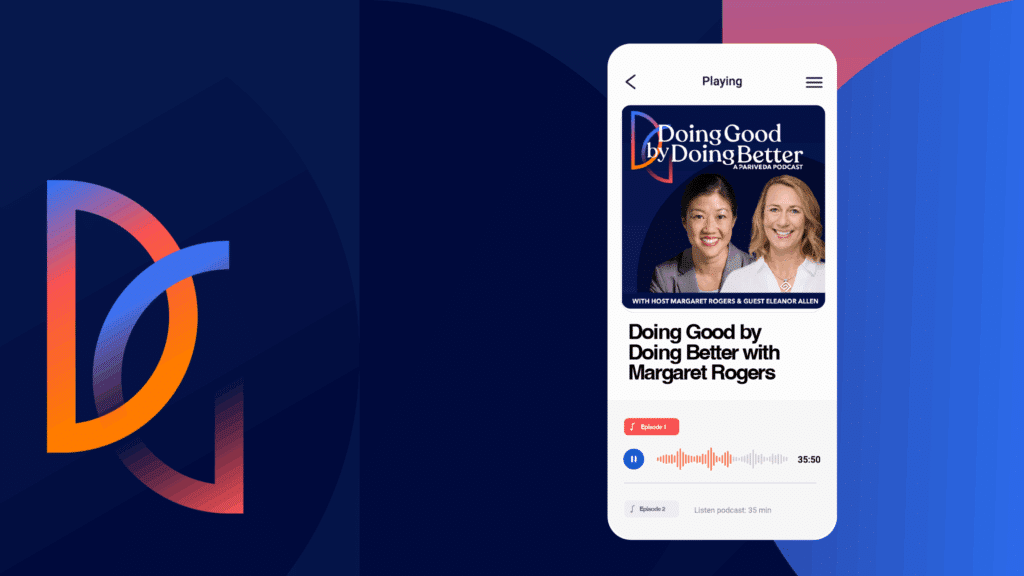Who else has replaced their leadership team with AI?
Ah, didn’t think so (and actually, neither have we). Despite the tumultuous AI furor, our most valuable team members remain human and—as statistics indicate—are as likely as not to be experiencing an exclusively human experience: burnout.
Burnout is the exhaustion, detachment, or sense of ineffectiveness/inadequacy we feel when prolonged stress isn’t properly managed. It reflects an imbalance in job demands (workload, expectations) and resources (support, clarity, rest, skills).
Over the past several years, employee burnout prevalence has hovered around all-time highs. It continues to bring with it a slew of negative impacts to projects for those who aren’t managing this impactful “shadow risk” [iii, iv]. Enter AI, with its incredible promise of faster decisions and vanishingly hands-off menial work. AI should help with burnout, right?
Unfortunately, that’s not turning out to be the case.
Recent research indicates that Director and Manager levels have the highest levels of burnout, and perhaps surprisingly, the burnout effect is more pronounced among people who use AI more heavily.[v] We could call this the AI-Burnout paradox.
We don’t know for sure yet why this is. It could be the increased effort needed to supervise the tool, job anxiety introduced by AI’s capabilities, or even from flipped causality: those who are burned out are turning more to AI in hopes of a panacea. Regardless of why, we know the effect is real.
But do we need to respond? Some may say that in a few years, stress and burnout won’t have a negative impact on business because “teams will be computerized.” I don’t think that’s true, because humans have something that AI doesn’t – and won’t for the foreseeable future.
AI can’t replace the human advantage
While AI is good and getting better at repetitive, pattern-driven work, it struggles with:
- creativity and innovation
- critical thinking
- common sense
- contextual judgement
- empathy and emotional intelligence
- dealing with ambiguity
- moral and ethical reasoning
As time progresses, these very human skills will solidify into the human advantage: the most important skills a human can develop and bring to their workplace to contribute to business success [vi].
Burnout, not AI, undermines the human advantage
Coincidentally, burnout hits these very traits the hardest [vii]. In other words, the most important current and future human skills of successful work are those most highly susceptible to the impacts of burnout. As AI continues to take a larger share of work, senior leaders must prioritize keeping their team’s most critical human skills sharp and available…which means protecting them from burnout.
So, as a senior leader, what can you do to help your team navigate the uncertainty and realize the opportunities of AI instead of falling prey to threats of burnout?
Let’s turn to the science to apply what we know about burnout to today’s AI-infused world.
What does the science say about employee burnout?
A well-validated clinical model by Christina Maslach and Michael Leiter suggests six Areas of Worklife that, if imbalanced, create burnout.[viii]
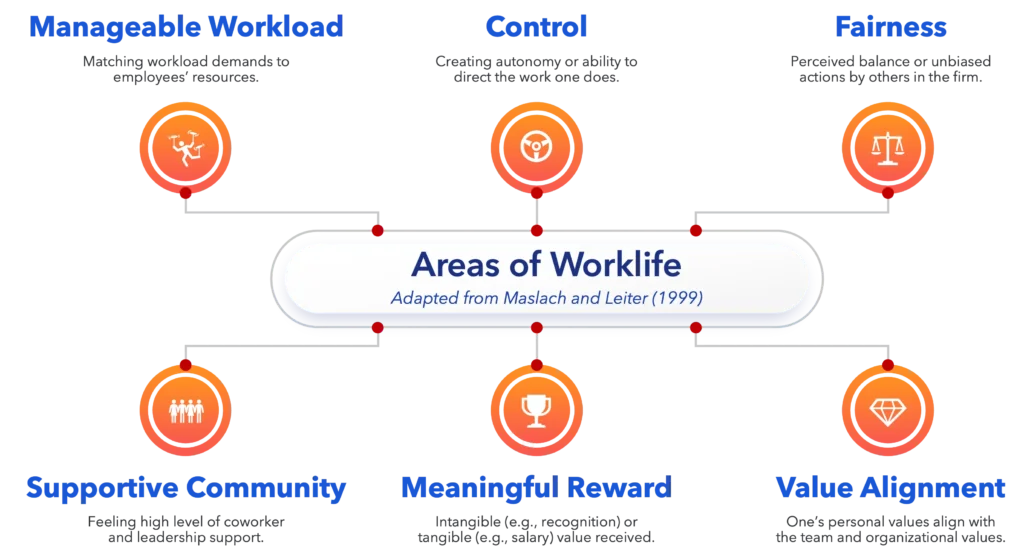
Let’s use these six Areas of Worklife as a simple framework to understand the opportunities and threats presented by AI, and what an effective leader will do in response. If you want to use AI in a way to help your team’s wellbeing and not hinder it, then look to maximize the opportunities and minimize the threats.
Prefer a downloadable one-pager?
1. Manageable workload
To maintain a manageable workload, employees’ workload demands must be matched to their resources.
Opportunities and threats: AI presents an unparalleled opportunity to accelerate and remove tedious work, but the threat is that shoehorning little-understood or unproven AI practices into their routines or their teams will add more demands than it helps.
Effective leadership strategy: Coach leaders to prioritize the deliberate, incremental adoption of AI to keep the workload reduced greater than the workload added. Check in regularly to evaluate workload impacts.
2. Control
Control refers to creating autonomy or the ability to direct the work one does, and is positively impacted by clearly defined roles.
Opportunities and threats: AI can help make decisions faster and allow team members to work more independently. On the other hand, there’s a risk of over-delegation of thinking to AI, which uses “crystalized best practices” that can remove creativity and make following its recommendations seem inevitable.
Effective leadership strategy: Test role clarity with AI to identify gaps and ensure human discretion in important decisions.
3. Fairness
Fairness is affected by perceived balance or unbiased actions of others within the firm.
Opportunities and threats: A great opportunity is to reduce bias by testing policy, messaging, hiring practices, and resource allocation with AI’s “neutral” perspective. Unfortunately, fairness can be threatened by algorithmic bias, a perception of over-delegation to AI, and even the “garbage in, garbage out” concept, where an AI’s output is subject to underlying model limitations and only as good as the context you provide it.
Effective leadership strategy: Test important actions with multiple AI models to reduce bias and make AI influence transparent and contestable. Supplement team members’ skill gaps with AI tools to level the playing field and promote equity in contributions.
4. Supportive community
Feeling a high level of coworker and leadership support contributes to a supportive community.
Opportunities and threats: With AI, you can tap into a wealth of ideas for connection and building cross-functional understanding. However, too much digital mediation (chatbots, auto-generated content) can backfire as messages and connective moments lose authenticity.
Effective leadership strategy: Lean into more authentic human experiences supported by AI rather than defined by it. Experiment with art, music, food, handwriting, in-person discussion, and mentoring.
5. Meaningful reward
Meaningful rewards are value received and can be intangible (e.g., recognition) or tangible (e.g., salary).
Opportunities and threats: AI is good at highlighting patterns of performance for you to recognize and reward. On the other hand, automated recognition loses meaning, and AI-driven metrics begin to feel lazy.
Effective leadership strategy: Combine AI-surfaced recognition with human flair and input.
6. Value alignment
Value alignment occurs when one’s personal values align with the team and organizational values.
Opportunities and threats: AI can create space to accelerate mission-aligned work and passion projects that benefit both employees and the business. The threat is that rapid AI adoption could conflict with the team’s more important, value-aligned work, or employees may feel that by adopting AI tools, the company is eroding its people-focused mission.
Effective leadership strategy: Set up personalized prompt coaching in your AI to request it consider your personal value statement every time it replies with an idea, and show your team how so they can do the same. Be an example of using AI for additive positive change rather than only subtractive change.
Be human with your humans
You may have noticed a pattern in the above recommendations: be human with your humans. When you do, you are deliberately contributing positively to the six Areas of Worklife and reducing burnout. You are leading your team into an optimistic future where AI complements the human advantage to create both a healthier and a more successful team.
What else can I do?
Effectively managing burnout in the age of AI requires more than just understanding these opportunities and threats; leaders must also cultivate broader burnout resilience through culture, structure, and process. Burnout management must be centered at the team level and driven by operations leaders (like PMO or delivery executives) to create sustainably high-performing teams.
While we have a full implementation framework and toolset for proactively managing burnout risks to strategic initiatives, the starting point is as simple as considering the ABCs of Burnout Management™:
A: Awareness of burnout, its effects, and that it’s a reality to manage, not a problem to solve
B: Belief that it can and must be managed for sustainable success
C: Commitment to do what it takes to build a culture of psychological safety and put into place the requisite structures, processes, and people elements to promote continual wellbeing
If you’d like to chat more about what this could look like in your organization, or simply want to exchange ideas, reach out for a quick overview or deeper conversation.
Remember that as AI equalizes the routine today, only the organizations that nurture human potential will unlock the extraordinary tomorrow.
Facing the AI-burnout paradox?
References
- [i] Quantum Workplace, & McFeely, S. (n.d.). Creating an engaging employee experience: The latest employee engagement trends. Quantum Workplace. Retrieved June 25, 2025, from https://www.quantumworkplace.com/employee-engagement-trends-report/employee-experience
- [ii] Kim, BJ., Lee, J. The mental health implications of artificial intelligence adoption: the crucial role of self-efficacy. Humanit Soc Sci Commun 11, 1561 (2024). https://doi.org/10.1057/s41599-024-04018-w
- [iii] Robinson, B., PhD. (2025, February 8). Job burnout at 66% in 2025, new study shows. Forbes. https://www.forbes.com/sites/bryanrobinson/2025/02/08/job-burnout-at-66-in-2025-new-study-shows/
- [iv] The Interview Guys. (2025, May 31). The State of Workplace Burnout in 2025: A Comprehensive Research report – The interview guys. https://blog.theinterviewguys.com/workplace-burnout-in-2025-research-report/
- [v] Quantum Workplace, & McFeely, S. (n.d.). Creating an engaging employee experience: The latest employee engagement trends. Quantum Workplace. Retrieved June 25, 2025, from https://www.quantumworkplace.com/employee-engagement-trends-report/employee-experience
- [vi] World Economic Forum. (2025). The Future of Jobs Report 2025. In World Economic Forum, 35. https://www.weforum.org/publications/the-future-of-jobs-report-2025/
- [vii] See, for example, the following:
- Zainab, B., Akbar, W., & Julie, N. T. V. (2020). Effects of burnout on employee creative performance and counterproductive work behavior: Does psychological capital matter? Paradigms, 14(1), 39–45. https://doi.org/10.24312/1930140106
- Koch, A. K., & Adler, M. (2018). Emotional exhaustion and innovation in the workplace—a longitudinal study. Industrial Health, 56(6), 524–538. https://doi.org/10.2486/indhealth.2017-0095Eschleman, K. J., Madsen, J., Alarcon, G., & Barelka, A. (2014). Benefiting from creative activity: The positive relationships between creative activity, recovery experiences, and performance‐related outcomes. Journal of Occupational and Organizational Psychology, 87(3), 579–598. https://doi.org/10.1111/joop.12064
- Eschleman, K. J., Madsen, J., Alarcon, G., & Barelka, A. (2014). Benefiting from creative activity: The positive relationships between creative activity, recovery experiences, and performance‐related outcomes. Journal of Occupational and Organizational Psychology, 87(3), 579–598. https://doi.org/10.1111/joop.12064
- Carmeli, A., Reiter-Palmon, R., & Ziv, E. (2010). Inclusive leadership and employee involvement in creative tasks in the workplace: the mediating role of psychological safety. Creativity Research Journal, 22(3), 250–260. https://doi.org/10.1080/10400419.2010.504654
- Gong, Z., Sun, F., & Li, X. (2021). Perceived Overqualification, emotional exhaustion, and creativity: A Moderated-Mediation Model based on Effort–Reward Imbalance Theory. International Journal of Environmental Research and Public Health, 18(21), 11367. https://doi.org/10.3390/ijerph182111367
- [viii] Maslach, C., & Leiter, M. P. (2016). Understanding the burnout experience: recent research and its implications for psychiatry. World Psychiatry, 15(2), 103–111. https://doi.org/10.1002/wps.20311
- [ix] Leiter, M. P., & Maslach, C. (1999). Six areas of worklife: a model of the organizational context of burnout. Journal of health and human services administration, 21(4), 472–489.










